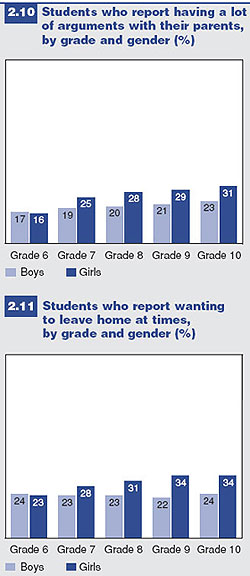Healthy settings for young people in Canada – Parental opinion and expectations

Despite decreasing reports of parental trust in the higher grades, the majority of students in all grades value what their parents think of them and express a desire for parental approval. Students in Grade 6 are the most concerned about what their parents think of them (Figure 2.7).

Text Equivalent - Figures 2.8-2.9
While both genders’ reports of parental expectations are the same (Figure 2.8), more boys than girls feel that their parents expect too much of them specifically regarding school (Figure 2.9). As high as 33% of students report that their parents’ expectations regarding school are too high.
Conflict with parents
The downward trend from Grade 6 to 10 in the percentage of students who value parental approval (see Figure 2.7) coincides with increasing trends in the percentage of students who have a lot of arguments with their parents (Figure 2.10) and with the percentage of students who want to leave home at times (Figure 2.11).
The sources of conflict between young people and their parents might be related to friends, money issues, watching television, telephone use, going out, time at homework, household chores, fighting with siblings, and issues related to increased independence.
The home setting
Summary
Approximately 2 in every 3 students in Canada live with both parents. Most students report having a happy home life. Older youths, especially girls, have more difficulty than younger ones in talking to their parents. Feeling understood and trusted by parents is less common in higher grades. Arguments with parents and wanting to leave home at times are more common in girls than in boys.
Measures used in this report
The living with both parents measure reflects students’ responses to the question about the people they live with. Students indicating that both their father and their mother live with them were classified as “yes” in relation to the measure; all students with other living arrangements were classified as “no.” A parent trust and communication scale was developed based on six survey items. Only those students with complete data for the six items were included.
Six survey items:
- Students’ ease of talking to mother about things that really bother them
- Students’ ease of talking to father about things that really bother them
- My parents understand me
- I have a happy home life
- My parents trust me
- What my parents think of me is important.
Page details
- Date modified:
